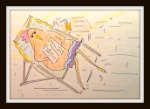In memoriam Bede College, A Co, 8th Battalion DLI…
Part 2
(click here for Part 1)
Enlisting in the Territorial Army just before the outbreak of WW1:
“Any smart lad who wants good pay, good food and good sport should join this distinguished regiment” @DLI_museum_
Picture credit: The Durham Light Infantry Museum
When WLS became a student at Durham in 1912, there was a Territorial Unit already attached to Bede College. He and his best friends, Tutty and Bob H enrolled immediately as did all their fellow undergraduates . None of them had any idea that WW1 was imminent and none of them had any intention of becoming soldiers rather than teachers.
Once a week, instead of playing sport in the afternoons, the Bede Collegers would put on their army field dress and were drilled by the Sergeant Instructor. They drilled, marched and practiced loading and firing their rifles. In the summers, they were sent off to Army Training Camps.
In 1914, there were 50 students in the Junior Year at Bede College Durham and 51 in the Senior Year. All were enlisted in the Territorial unit attached to the College and together they formed A Company of the 8th Battalion, Durham Light Infantry. In those days, a Company was made up of 100 men, 8 companies forming together to make up the Battalion. When A Company was sent to the Front in 1915, 99 men from Bede went to France. The only 2 who were missing were one who was medically unfit and one CO (conscientious objector).
WW1 Army Training Camps:
Years later, the distinguished American John Pershing (who became General of the Armies,the highest authorised rank in the United States Army), wrote about British Army Training Camps during this time:
Training
“Soon after our arrival in Europe careful study was made of the methods followed by our Allies in training combat troops. Both the French and British maintained continuously a great system of schools and training centres, which provided for both theoretical and practical instruction of inexperienced officers and non-commissioned officers.
These centres were required not only to train new troops, but to prepare officers and soldiers for advancement by giving them a short course in the duties of their new grades. These school systems made it possible to spread rapidly a knowledge of the latest methods developed by experience and at the same time counteract false notions…
…The rifle and the bayonet are the principal weapons of the infantry soldier. He will be trained to a high degree of skill as a marksman, both on the target range and in field firing. An aggressive spirit must be developed until the soldier feels himself, as a bayonet fighter, invincible in battle…”
By 1914, these camps were dotted all around the country.
In an article written for the Summer 2014 edition (no.28) of The Durham Bugle (the magazine of the DLI Museum Friends and the DLI), Harry Moses writes:
Annual Territorial Camp in July was eagerly looked forward to… Held over two weeks, manoeuvres, drills, shooting and field exercises took place. Competitions were organised and Bede men […] performed very well.
In the Autumn 2014 edition of the same magazine, Harry Moses states, ‘Annual camps gave a short experience of ‘real’ soldiering.‘ He continues with his account of the Training camp experiences of The Bede College Contingent, A Co. 8th Bn DLI, writing :
The 1912 camp was held …in very heavy rain which turned the fields into a sea of mud. There were many moans about the mud and the almost impossible task of keeping clean. Tents were errected, palliasses filled, which soon became damp in the inclement weather. Manoeuvres, drills and route marches in full marching order filled much of the time. Rations were issued – sausages, coffee and bread – and each unit did its own cooking. Some men were trained as scouts and took part in exercises to loacate an ‘enemy’ with much hilarity when they lost their way and failed to find the objective!
Durham Light Infantry recruits in training, 1915.
Picture credit: Tynemouth 1914-18
Sometimes the soldiers were housed in wooden huts but the students from Bede College camped out in tents like the ones pictured below.
Manchester Training Camp:
Ashridge Camp, Ashridge Park, Herts, Training Camp
In all, WLS together with his fellow students from Bede spent a month in Army Training Camps in Scarborough and Conway.
At the Camps, they were issued with their kit including several pairs of Army Ammunition boots. Most of these apparently they immediately sold on to miners who deemed them perfect for working down the pits. (I shouldn’t think John Pershing or his fellow British Army bigwigs knew about this particular method of income supplementation.)
One pair of Army Ammunition boots however, WLS made sure to hang onto for as he said later, they were the ‘most comfortable boots I ever had in my life!’
Apparently they lasted him throughout the 15 months he spent serving in the Army and ensured he never any trouble with his feet whilst in the trenches.
Years later, WLS made a recording about his memories of those days, He didn’t mention anything that sounds at all like John Pershing’s description of training camps – nothing about being “trained to a high degree of skill as a marksman, both on the target range and in field firing” or about being turned into “… a bayonet fighter, invincible in battle” .
Instead WLS seemed to have only happy memories of his Training Camp days. He described how they were given every afternoon off to go off into Scarborough or Conway to have fun and gave his verdict as, “We all enjoyed it!”.
In this photograph taken at Conway Army Training Camp in 1914, these 10 friends from Bede are posing for the camera in front of their field tent with their pipes & bottles of beer placed as prominently as their rifles & bayonets. WLS (aged 20) is pictured seated in the second row in the middle of the group, Tutty is in the middle of the top row without a cap, leaning on Bob H (in field dress) next to the chap with the mallet on his shoulder.
None of these young men had factored the outbreak of WW1 into their plans for the future.
Yours ever,
(Click here for Part 1)


 Tynemouth 1914-18
Tynemouth 1914-18






 Lady Liberty Hen
Lady Liberty Hen
 The Agent
The Agent  The Rev. Rosecomb (aka Trev the Rev)
The Rev. Rosecomb (aka Trev the Rev)  The Graf von Blommehön
The Graf von Blommehön  Lady Lohmann-Brown
Lady Lohmann-Brown  Lady Egality Maran
Lady Egality Maran  Sir Plymouth Rock
Sir Plymouth Rock  Brown Owl
Brown Owl  Lady Eftie Nudge
Lady Eftie Nudge  Julia. I'm allowed to be present at editorial meetings so long as I sit at the back & colour in quietly.
Julia. I'm allowed to be present at editorial meetings so long as I sit at the back & colour in quietly. 
That’s really interesting, thanks for such an informative post.
Thanks so much Emma, I’ll tell the Agent and he’ll be so pleased!
What a wonderful piece. I have never seen any of these photos before. WLS looks very dour in the group photo. Is there going to be a part 3?
I know he’s not exactly crying with laughter but if you look hard , WLS is holding his pipe all wrong with the pipe bowl tipped over so I think they were all trying to look grown up & serious as a joke! The Agent says part 3 will follow shortly – he’s done loads of investigating!
Fantastic
Oh I’m so glad you like it 🙂 The photo taken at Conway is fabulous, isn’t it?